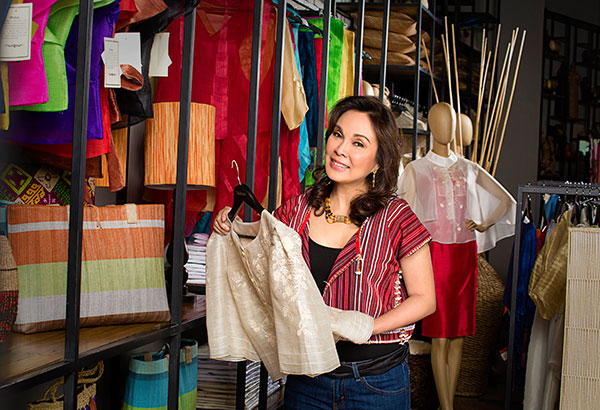Sen. Loren Legarda and Kultura: Bringing Filipino fashion to the mainstream
August 24, 2014
MANILA, Philippines – During the President’s recent State of the Nation Address (SONA), Senator Loren Legarda turned heads when she wore a traditional attire of the Mandaya indigenous community composed of a bado (blouse) with embroidered geometric designs of colorful threads and beads, and a dagmay (handwoven skirt) made of abaca strips, dyed using organic colorants from plants and herbs.
Earlier that day, she had attended the opening of the Second Regular Session of the 16th Congress, wearing a kinamayan skirt handwoven by the Tingguians of Abra. The skirt is designed with frogs that depict abundance, “3 kamay” that represents the growing palay, and the joinery at the edges represents the hands that planted the rice. She also wore a pangalapang necklace, one of the ornaments of the Cordillera people in the eastern Ifugao region. It is made of six pieces of mother of pearl formed into flat trapezoidal shapes and connected by a thin rope of finely braided rattan.
Her fashion choices are in keeping with her “lifelong passion to explore the indigenous artistry of Filipinos told through traditional textiles. Our vibrant traditional textiles are revelations of the Filipino’s indigenous life, reflections of our cultural rootedness, and symbols of our identity.”
Her passion had led her to author Republic Act 9242, the Philippine Tropical Fabrics Law, which promotes the country’s natural fabrics through their use for official uniforms of government employees.
The same fervor has inspired her to spearhead programs to create awareness about the country’s weaving traditions and cultural heritage through the Hibla ng Lahing Filipino Gallery, the country’s first permanent textile exhibit at the Museum of the Filipino People. She also supports the National Museum’s Lecture Series on Philippine Traditional Textiles and Indigenous Knowledge.
“The tropical fabrics industry has great potential in the world market,” she says. “We already have the raw materials and the skill to start with — sturdy abaca from all over the country; banana fiber from plantations in Sultan Kudarat and Davao; delicate pineapple fiber from Camarines Norte and Mindanao; and precious silk from Negros Occidental and Benguet.
This is a passion she shares with Kultura Filipino, which she says, “has been promoting “fashionalism” — fashion with nationalism — by selling only products that are not only locally made but also represent Filipino traditions and culture.”
During a visit to Kultura at SM Aura Premier, Senator Legarda was fascinated by the contemporary Filipiniana collection in the store. Indigenous fabrics were transformed into modern pieces — mantons made of abaca, silk ponchos, and piña silk blouses — bringing these into the fashion mainstream, and hopefully to a more global market.
There were also a wide selection of elegant evening bags and accessories — mother-of-pearl clutch bags and jewelry with agate stones and South Sea pearls.
“Kultura features a wide selection of tropical garments, woven bags and Filipino-made accessories that can be worn and used in the office and even during casual and formal gatherings,” she says.
More than that, “being located in SM malls, Kultura stores are able to attract more Filipinos and foreign tourists alike to consider indigenous and local garments as part of their everyday wardrobe.”
Kultura stores are located at SM Aura Premier, SM Makati, SM Megamall, SM City North EDSA-Annex, SM Mall of Asia, SM City Cebu and at selected SM Stores.
Source: Philstar

